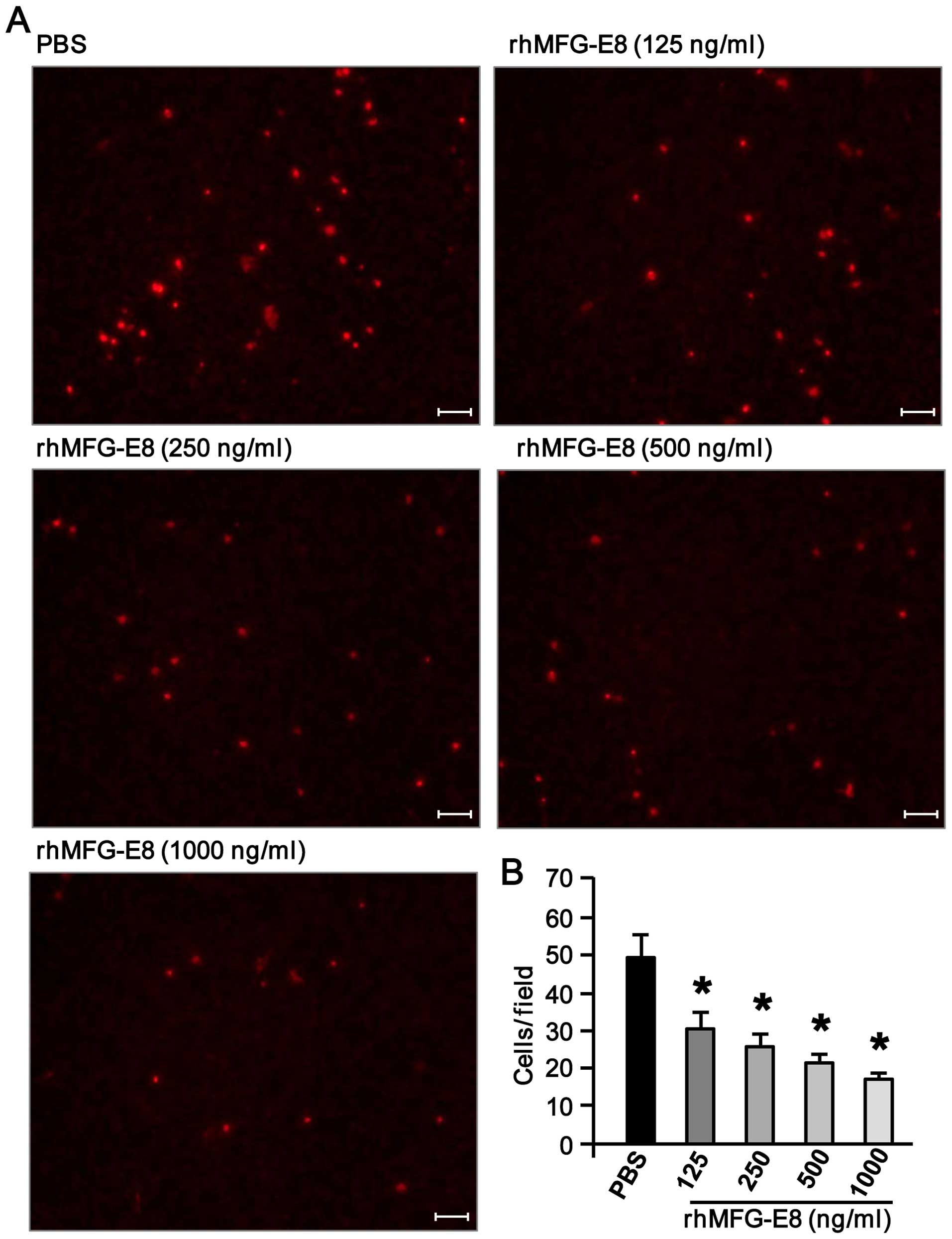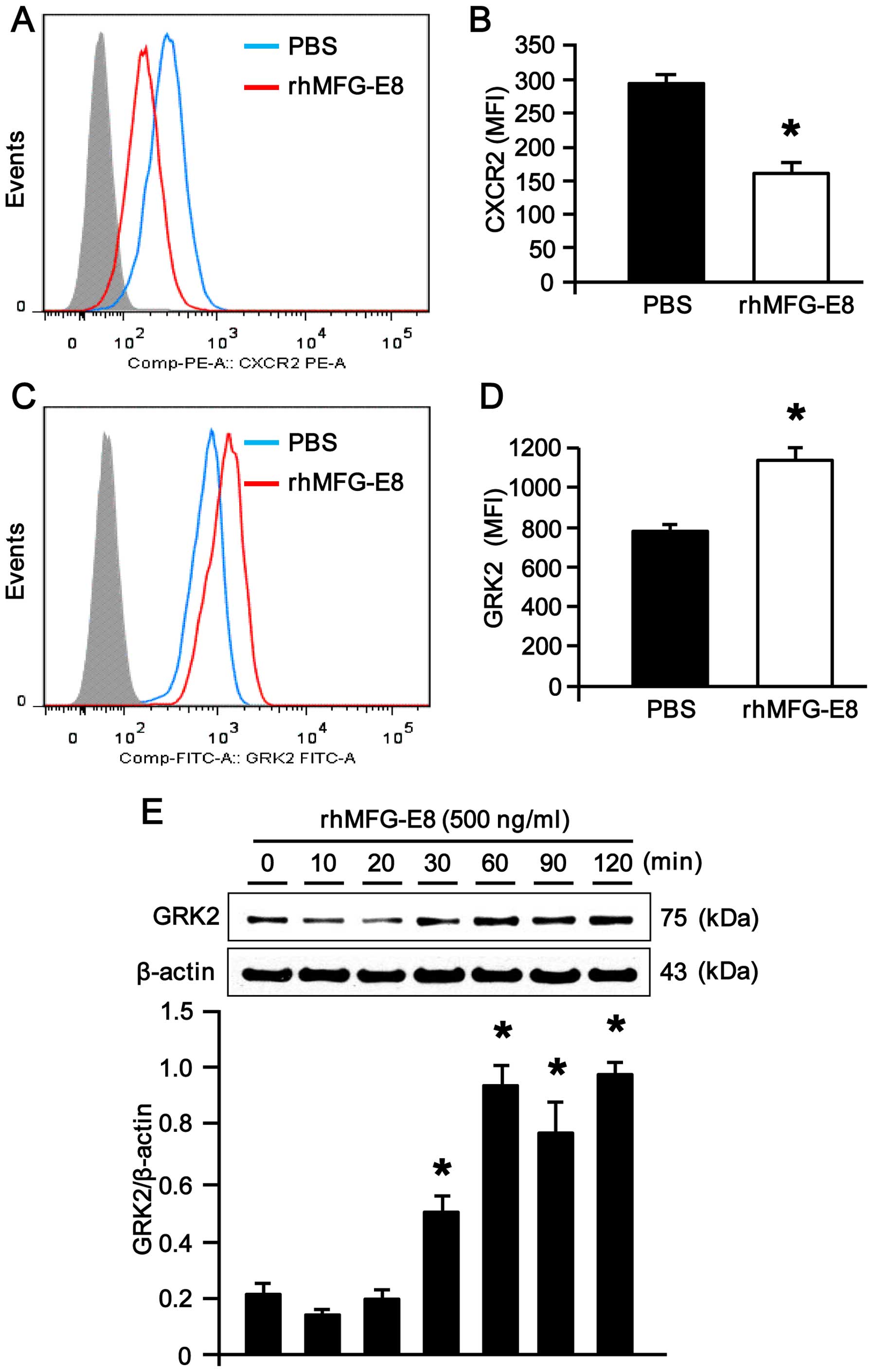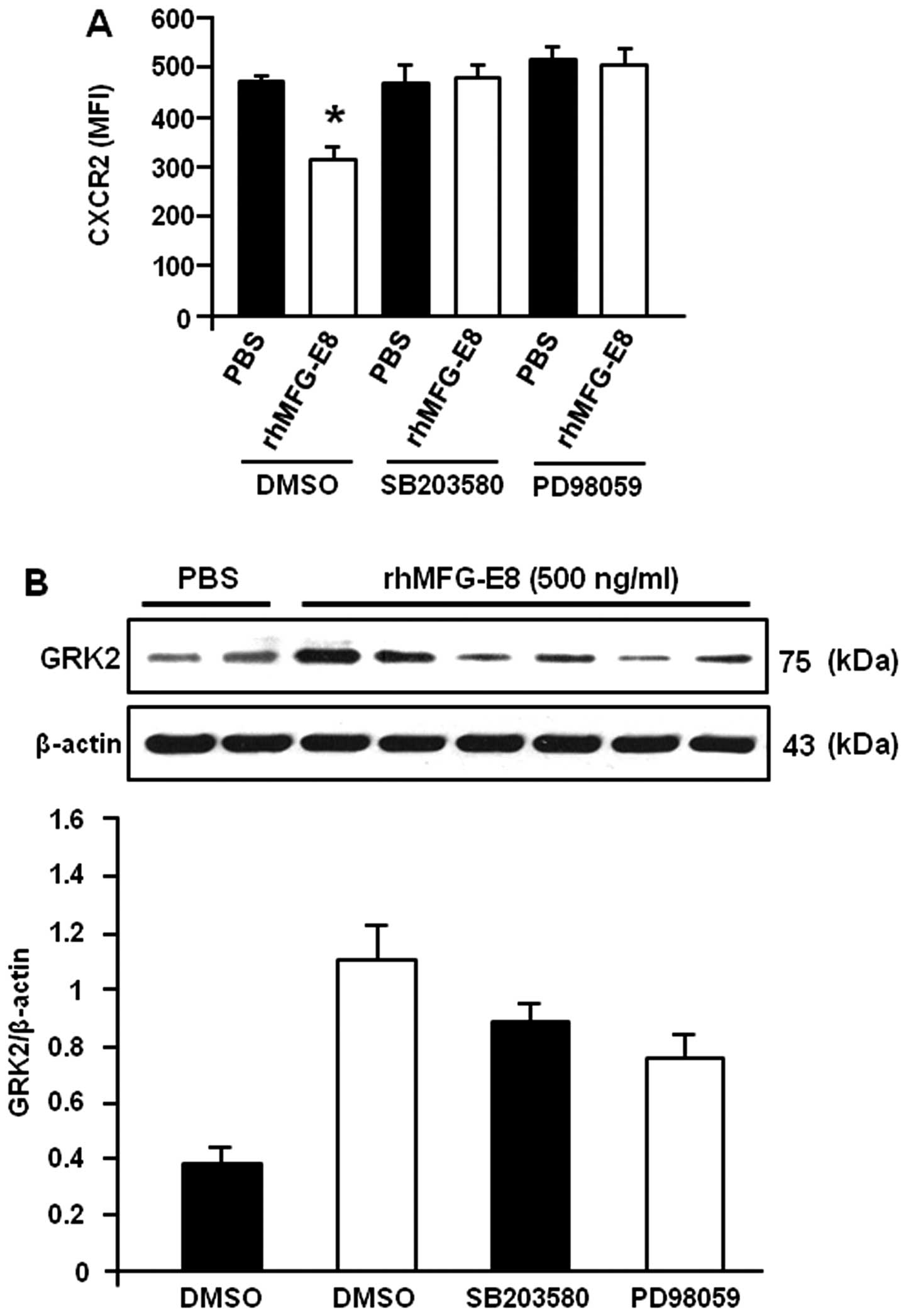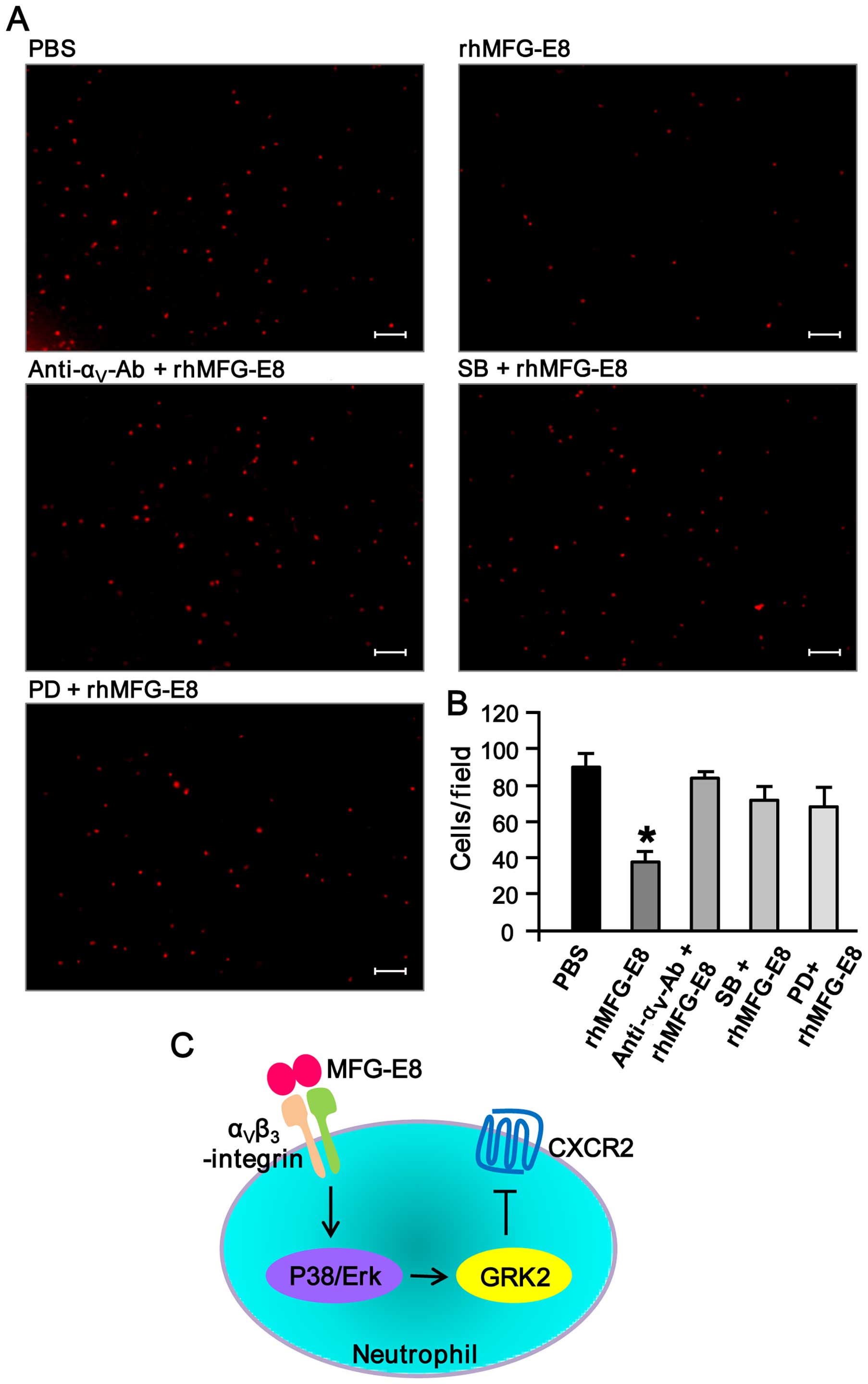|
1
|
Nathan C: Neutrophils and immunity:
Challenges and opportunities. Nat Rev Immunol. 6:173–182. 2006.
View Article : Google Scholar : PubMed/NCBI
|
|
2
|
Rot A and von Andrian UH: Chemokines in
innate and adaptive host defense: basic chemokinese grammar for
immune cells. Annu Rev Immunol. 22:891–928. 2004. View Article : Google Scholar : PubMed/NCBI
|
|
3
|
Etzioni A and Tonetti M: Leukocyte
adhesion deficiency II-from A to almost Z. Immunol Rev.
178:138–147. 2000. View Article : Google Scholar
|
|
4
|
Webb PR, Wang KQ, Scheel-Toellner D,
Pongracz J, Salmon M and Lord JM: Regulation of neutrophil
apoptosis: a role for protein kinase C and
phosphatidylinositol-3-kinase. Apoptosis. 5:451–458. 2000.
View Article : Google Scholar
|
|
5
|
Ayala A, Chung CS, Lomas JL, Song GY,
Doughty LA, Gregory SH, Cioffi WG, LeBlanc BW, Reichner J, Simms HH
and Grutkoski PS: Shock-induced neutrophil mediated priming for
acute lung injury in mice: divergent effects of TLR-4 and
TLR-4/FasL deficiency. Am J Pathol. 161:2283–2294. 2002. View Article : Google Scholar : PubMed/NCBI
|
|
6
|
Abraham E: Neutrophils and acute lung
injury. Crit Care Med. 31(Suppl): S195–S199. 2003. View Article : Google Scholar : PubMed/NCBI
|
|
7
|
Aziz M, Jacob A, Yang W-L, Matsuda A and
Wang P: Current trends in inflammatory and immunomodulatory
mediators in sepsis. J Leukoc Biol. 93:329–342. 2013. View Article : Google Scholar :
|
|
8
|
Aziz M, Matsuda A, Yang W-L, Jacob A and
Wang P: Milk fat globule-epidermal growth factor-factor 8
attenuates neutrophil infiltration in acute lung injury via
modulation of CXCR2. J Immunol. 189:393–402. 2012. View Article : Google Scholar : PubMed/NCBI
|
|
9
|
Cui T, Miksa M, Wu R, Komura H, Zhou M,
Dong W, Wang Z, Higuchi S, Chaung W, Blau SA, et al: Milk fat
globule epidermal growth factor 8 attenuates acute lung injury in
mice after intestinal ischemia and reperfusion. Am J Respir Crit
Care Med. 181:238–246. 2010. View Article : Google Scholar :
|
|
10
|
Wagner JG and Roth RA: Neutrophil
migration mechanisms, with an emphasis on the pulmonary
vasculature. Pharmacol Rev. 52:349–374. 2000.PubMed/NCBI
|
|
11
|
Lee WL and Downey GP: Neutrophil
activation and acute lung injury. Curr Opin Crit Care. 7:1–7. 2001.
View Article : Google Scholar : PubMed/NCBI
|
|
12
|
Zarbock A and Ley K: Mechanisms and
consequences of neutrophil interaction with the endothelium. Am J
Pathol. 172:1–7. 2008. View Article : Google Scholar :
|
|
13
|
Donnelly SC, Strieter RM, Kunkel SL, Walz
A, Robertson CR, Carter DC, Grant IS, Pollok AJ and Haslett C:
Interleukin-8 and development of adult respiratory distress
syndrome in at-risk patient groups. Lancet. 341:643–647. 1993.
View Article : Google Scholar : PubMed/NCBI
|
|
14
|
Goodman RB, Strieter RM, Martin DP,
Steinberg KP, Milberg JA, Maunder RJ, Kunkel SL, Walz A, Hudson LD
and Martin TR: Inflammatory cytokines in patients with persistence
of the acute respiratory distress syndrome. Am J Respir Crit Care
Med. 154:602–611. 1996. View Article : Google Scholar : PubMed/NCBI
|
|
15
|
Olson TS and Ley K: Chemokines and
chemokine receptors in leukocyte trafficking. Am J Physiol Regul
Integr Comp Physiol. 283:R7–R28. 2002. View Article : Google Scholar : PubMed/NCBI
|
|
16
|
Reutershan J, Morris MA, Burcin TL, Smith
DF, Chang D, Saprito MS and Ley K: Critical role of endothelial
CXCR2 in LPS-induced neutrophil migration into the lung. J Clin
Invest. 116:695–702. 2006. View Article : Google Scholar : PubMed/NCBI
|
|
17
|
Murphy PM: Neutrophil receptors for
interleukin-8 and related CXC chemokines. Semin Hematol.
34:311–318. 1997.PubMed/NCBI
|
|
18
|
Johnston RA, Mizgerd JP and Shore SA:
CXCR2 is essential for maximal neutrophil recruitment and
methacholine responsiveness after ozone exposure. Am J Physiol Lung
Cell Mol Physiol. 288:L61–L67. 2005. View Article : Google Scholar
|
|
19
|
Vroon A, Heijnen CJ and Kavelaars A: GRKs
and arrestins: Regulators of migration and inflammation. J Leukoc
Biol. 80:1214–1221. 2006. View Article : Google Scholar : PubMed/NCBI
|
|
20
|
Chuang TT, Iacovelli L, Sallese M and De
Blasi A: G protein- coupled receptors: Heterologous regulation of
homologous desensitization and its implications. Trends Pharmacol
Sci. 17:416–421. 1996. View Article : Google Scholar : PubMed/NCBI
|
|
21
|
Aragay AM, Ruiz-Gómez A, Penela P, Sarnago
S, Elorza A, Jiménez-Sainz MC and Mayor F Jr: G protein-coupled
receptor kinase 2 (GRK2): mechanisms of regulation and
physiological functions. FEBS Lett. 430:37–40. 1998. View Article : Google Scholar : PubMed/NCBI
|
|
22
|
Penn RB, Pronin AN and Benovic JL:
Regulation of G protein-coupled receptor kinases. Trends Cardiovasc
Med. 10:81–89. 2000. View Article : Google Scholar
|
|
23
|
Penela P, Ribas C and Mayor F Jr:
Mechanisms of regulation of the expression and function of G
protein-coupled receptor kinases. Cell Signal. 15:973–981. 2003.
View Article : Google Scholar : PubMed/NCBI
|
|
24
|
Pitcher JA, Tesmer JJ, Freeman JL, Capel
WD, Stone WC and Lefkowitz RJ: Feedback inhibition of G
protein-coupled receptor kinase 2 (GRK2) activity by extracellular
signal-regulated kinases. J Biol Chem. 274:34531–34534. 1999.
View Article : Google Scholar : PubMed/NCBI
|
|
25
|
Liu X, Ma B, Malik AB, Tang H, Yang T, Sun
B, Wang G, Minshall RD, Li Y, Zhao Y, et al: Bidirectional
regulation of neutrophil migration by mitogen-activated protein
kinases. Nat Immunol. 13:457–464. 2012. View Article : Google Scholar : PubMed/NCBI
|
|
26
|
Hanayama R, Tanaka M, Miwa K, Shinohara A,
Iwamatsu A and Nagata S: Identification of a factor that links
apoptotic cells to phagocytes. Nature. 417:182–187. 2002.
View Article : Google Scholar : PubMed/NCBI
|
|
27
|
Hanayama R, Tanaka M, Miyasaka K, Aozasa
K, Koike M, Uchiyama Y and Nagata S: Autoimmune disease and
impaired uptake of apoptotic cells in MFG-E8-deficient mice.
Science. 304:1147–1150. 2004. View Article : Google Scholar : PubMed/NCBI
|
|
28
|
Ensslin MA and Shur BD: Identification of
mouse sperm SED1, a bimotif EGF repeat and discoidin-domain protein
involved in sperm-egg binding. Cell. 114:405–417. 2003. View Article : Google Scholar : PubMed/NCBI
|
|
29
|
Hanayama R and Nagata S: Impaired
involution of mammary glands in the absence of milk fat globule EGF
factor 8. Proc Natl Acad Sci USA. 102:16886–16891. 2005. View Article : Google Scholar : PubMed/NCBI
|
|
30
|
Ensslin MA and Shur BD: The EGF repeat and
discoidin domain protein, SED1/MFG-E8, is required for mammary
gland branching morphogenesis. Proc Natl Acad Sci USA.
104:2715–2720. 2007. View Article : Google Scholar : PubMed/NCBI
|
|
31
|
Aziz M, Jacob A, Matsuda A, Wu R, Zhou M,
Dong W, Yang W-L and Wang P: Pre-treatment of recombinant mouse
MFG-E8 downregulates LPS-induced TNF-α production in macrophages
via STAT3-mediated SOCS3 activation. PLoS One. 6:e276852011.
View Article : Google Scholar
|
|
32
|
Brissette MJ, Lepage S, Lamonde AS, Sirois
I, Groleau J, Laurin LP and Cailhier JF: MFG-E8 released by
apoptotic endothelial cells triggers anti-inflammatory macrophage
reprogramming. PLoS One. 7:e363682012. View Article : Google Scholar : PubMed/NCBI
|
|
33
|
Matsuda A, Jacob A, Wu R, Zhou M, Nicastro
JM, Coppa GF and Wang P: Milk fat globule-EGF factor VIII in sepsis
and ischemia-reperfusion injury. Mol Med. 17:126–133. 2011.
View Article : Google Scholar :
|
|
34
|
Nuzzi PA, Lokuta MA and Huttenlocher A:
Analysis of neutrophil chemotaxis. Methods Mol Biol. 370:23–36.
2007. View Article : Google Scholar : PubMed/NCBI
|
|
35
|
Qiang X, Li J, Wu R, Ji Y, Chaung W, Dong
W and Wang P: Expression and characterization of recombinant human
milk fat globule-EGF factor VIII. Int J Mol Med. 28:1071–1076.
2011.PubMed/NCBI
|
|
36
|
Schneider CA, Rasband WS and Eliceiri KW:
NIH Image to ImageJ: 25 years of image analysis. Nat Methods.
9:671–675. 2012. View Article : Google Scholar : PubMed/NCBI
|
|
37
|
Belperio JA, Keane MP, Burdick MD, Londhe
V, Xue YY, Li K, Phillips RJ and Strieter RM: Critical role for
CXCR2 and CXCR2 ligands during the pathogenesis of
ventilator-induced lung injury. J Clin Invest. 110:1703–1716. 2002.
View Article : Google Scholar : PubMed/NCBI
|
|
38
|
Matsuda A, Wu R, Jacob A, Komura H, Zhou
M, Wang Z, Aziz MM and Wang P: Protective effect of milk fat
globule-epidermal growth factor-factor VIII after renal
ischemia-reperfusion injury in mice. Crit Care Med. 39:2039–2047.
2011. View Article : Google Scholar : PubMed/NCBI
|
|
39
|
Brooks PC, Clark RA and Cheresh DA:
Requirement of vascular integrin alpha v beta 3 for angiogenesis.
Science. 264:569–571. 1994. View Article : Google Scholar : PubMed/NCBI
|
|
40
|
Cheyuo C, Jacob A, Wu R, Zhou M, Qi L,
Dong W, Ji Y, Chaung WW, Wang H, Nicastro J, et al: Recombinant
human MFG-E8 attenuates cerebral ischemic injury: Its role in
anti-inflammation and anti-apoptosis. Neuropharmacology.
62:890–900. 2012. View Article : Google Scholar :
|
|
41
|
Aziz MM, Ishihara S, Mishima Y, Oshima N,
Moriyama I, Yuki T, Kadowaki Y, Rumi MA, Amano Y and Kinoshita Y:
MFG-E8 attenuates intestinal inflammation in murine experimental
colitis by modulating osteopontin-dependent alphavbeta3 integrin
signaling. J Immunol. 182:7222–7232. 2009. View Article : Google Scholar : PubMed/NCBI
|
|
42
|
Bu HF, Zuo XL, Wang X, Ensslin MA, Koti V,
Hsueh W, Raymond AS, Shur BD and Tan XD: Milk fat globule-EGF
factor 8/lactadherin plays a crucial role in maintenance and repair
of murine intestinal epithelium. J Clin Invest. 117:3673–3683.
2007.PubMed/NCBI
|
|
43
|
Jinushi M, Nakazaki Y, Carrasco DR,
Draganov D, Souders N, Johnson M, Mihm MC and Dranoff G: Milk fat
globule EGF-8 promotes melanoma progression through coordinated Akt
and twist signaling in the tumor microenvironment. Cancer Res.
68:8889–8898. 2008. View Article : Google Scholar : PubMed/NCBI
|
|
44
|
Raymond A, Ensslin MA and Shur BD:
SED1/MFG-E8: A bi-motif protein that orchestrates diverse cellular
interactions. J Cell Biochem. 106:957–966. 2009. View Article : Google Scholar : PubMed/NCBI
|
|
45
|
Alves-Filho JC, Sônego F, Souto FO,
Freitas A, Verri WA Jr, Auxiliadora-Martins M, Basile-Filho A,
McKenzie AN, Xu D, Cunha FQ, et al: Interleukin-33 attenuates
sepsis by enhancing neutrophil influx to the site of infection. Nat
Med. 16:708–712. 2010. View Article : Google Scholar : PubMed/NCBI
|
|
46
|
Oda K, Matsuoka Y, Funahashi A and Kitano
H: A comprehensive pathway map of epidermal growth factor receptor
signaling. Mol Syst Biol. 1:00102005. View Article : Google Scholar
|
|
47
|
Reynolds CM, Eguchi S, Frank GD and Motley
ED: Signaling mechanisms of heparin-binding epidermal growth
factor-like growth factor in vascular smooth muscle cells.
Hypertension. 39:525–529. 2002. View Article : Google Scholar : PubMed/NCBI
|
|
48
|
Liu ZJ, Xiao M, Balint K, Smalley KS,
Brafford P, Qiu R, Pinnix CC, Li X and Herlyn M: Notch1 signaling
promotes primary melanoma progression by activating
mitogen-activated protein kinase/phosphatidylinositol 3-kinase-Akt
pathways and up-regulating N-cadherin expression. Cancer Res.
66:4182–4190. 2006. View Article : Google Scholar : PubMed/NCBI
|
|
49
|
Goruppi S, Ruaro E and Schneider C: Gas6,
the ligand of Axl tyrosine kinase receptor, has mitogenic and
survival activities for serum starved NIH3T3 fibroblasts. Oncogene.
12:471–480. 1996.PubMed/NCBI
|
|
50
|
Hidai C, Zupancic T, Penta K, Mikhail A,
Kawana M, Quertermous EE, Aoka Y, Fukagawa M, Matsui Y, Platika D,
et al: Cloning and characterization of developmental endothelial
locus-1: an embryonic endothelial cell protein that binds the
alphavbeta3 integrin receptor. Genes Dev. 12:21–33. 1998.
View Article : Google Scholar : PubMed/NCBI
|
|
51
|
Hanayama R, Tanaka M, Miwa K and Nagata S:
Expression of developmental endothelial locus-1 in a subset of
macrophages for engulfment of apoptotic cells. J Immunol.
172:3876–3882. 2004. View Article : Google Scholar : PubMed/NCBI
|
|
52
|
Choi EY, Chavakis E, Czabanka MA, Langer
HF, Fraemohs L, Economopoulou M, Kundu RK, Orlandi A, Zheng YY,
Prieto DA, et al: Del-1, an endogenous leukocyte-endothelial
adhesion inhibitor, limits inflammatory cell recruitment. Science.
322:1101–1104. 2008. View Article : Google Scholar : PubMed/NCBI
|















